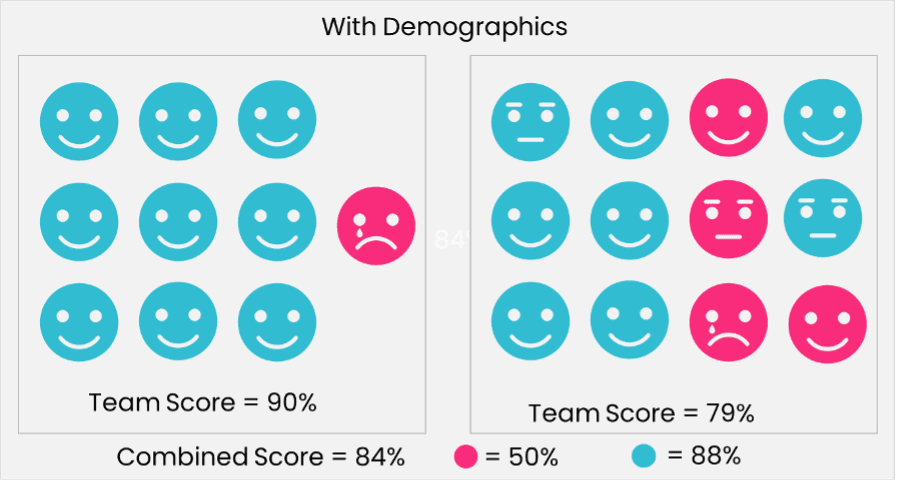How including demographic data in your employee survey supports ED&I?
I often find that clients are nervous about using potentially sensitive demographic information, including protected characteristics, to analyse their employee survey. While their fears are legitimate, in this post I’ll outline why you absolutely should, and the more the better for equity, diversity and inclusion (ED&I).
What do we mean by sensitive demographic information and why is it a concern?
Let’s cut to the chase. I’m talking about things like gender, ethnicity, sexuality, disability and religious beliefs. These are sensitive or protected characteristics because they have been, and continue to be, used to discriminate against particular employees.
It’s understandable, therefore, that people might be concerned about their data being used in an employee survey, particularly in a low-trust environment. We must therefore demonstrate that it’s in their best interest for us to use their data AND that it’s safe for them to do so.
Let’s tackle these concerns separately.
Why should you use protected characteristics to analyse your survey data?
By definition, most of the protected characteristics represent a minority. Although that’s not always true, for example in the case of gender, it’s likely that it is in certain parts or levels of your organisation.
The fact that we’re talking about minorities is at the crux of why you should use detailed demographic data in your survey analysis.
Imagine that in Marketing, there is one female employee, Martha. She feels left out, overlooked and is generally unhappy. There are nine males.
Let’s take a very simple measure of belonging, “I feel that I belong here”. Martha strongly disagrees with this statement while her male teammates strongly agree.
As you can see below, the team’s score would be an outstanding 90% (by our scoring system, which I’ll happily explain over a coffee). Certainly not ringing any alarm bells!

Now, imagine that a similar pattern is repeated across more teams. Maybe the team sizes and ratios are slightly different, but there’s a pattern nonetheless, of females feeling less like they belong than males. With the demographic information, the picture looks much different (below) than without.

You would want to know that. As you would if females felt less engaged, less well-managed and so on.
You wouldn’t know if you didn’t include gender data in your survey (either in the pre-loaded people data or by asking in the survey).
If you don’t know, you can’t do anything about it, not at a collective level. You’re dependent on those individuals speaking up and someone joining the dots. But what if they don’t feel safe to, or what if they’re treated as isolated cases?
So let me say again: You absolutely should include as much detailed demographic information in your survey as you can if you’re at all interested in belonging or ED&I.
And if Martha is anxious about being identified, that’s not a reason not to do it, but a reason to help her understand that it’s in her interests and that her identity is safe.
Sensitive information, employee surveys and GDPR
First, let’s cover off a concern that some clients have, whether it’s legitimate to use this information under GDPR.
The question is: Why are you using it?
The answer is: To provide a better employee experience.
Not just for your most typical employees, but for all.
That’s an unambiguously legitimate interest, even if you have not explicitly asked for consent to use their data to run employee surveys (though you’ll likely have covered off more general use in their contract and/or your data policy).
Now, to the important bit. How do you ensure that their data is not shared or used inappropriately?
First, your provider should have certification, such as ISO 27001, that demonstrates that they meet standards of information security, as a business (not just the hosting service they run their application on).
And you should have a data processing agreement with them that puts both organisations’ obligations in writing.
But what should you expect from your survey provider, to protect privacy?
They should provide a secure, GDPR-compliant transfer and storage process for your people's data (taking people out of the picture with an API from your HR system is even better).
They should anonymise - remove any identifying information from - the data before analysis. We run the survey on one server and analyse the data on another. Names are removed and dates of birth converted into age ranges, for example, before the data is sent on to analytics.
They should have additional safeguards, so that you can’t work out who a particular respondent is, for example by removing all groups of less than five individuals from charts.
Trust must be earned
If your people have reasons to mistrust you, of course, that’s going to be reflected in participation rates and you’re going to have to work hard to get them on board. But that’s not a reason to shy away from helping those people in your organisation that might be feeling mismanaged, marginalized or disengaged.
Instead, it’s our view that you should tackle concerns head-on, make a clear commitment to use their data responsibly and use it to drive change. Don’t expect instant trust. That’s earned over time, but when people see that you’re being responsible and responsive to their concerns, it will come.
If you want to find out more about the information from this blog, talk with Rob or book a demo to view the platform here.
